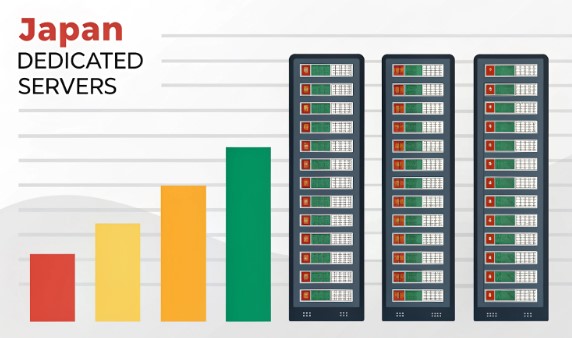How to Optimize High CPU Load on Japan Dedicated Servers

Managing CPU load on the Japan dedicated servers requires a sophisticated approach combining system-level optimization, security measures, and performance tuning. This comprehensive guide explores advanced techniques for tech professionals dealing with high CPU utilization in Japan hosting environments.
Understanding CPU Load Fundamentals
Before diving into optimization techniques, it’s crucial to grasp the technical aspects of CPU load metrics. In Linux environments, load average represents the number of processes waiting in the run-queue plus the number currently executing.
- Load average below 1.0: System is underutilized
- Load average equals CPU cores: Optimal utilization
- Load average exceeds CPU cores: Performance degradation likely
Key Monitoring Commands for CPU Analysis
Essential Linux commands for diagnosing CPU issues:
- top -c: Real-time process monitoring with command details
- htop: Interactive process viewer with color coding
- vmstat 1: Virtual memory statistics every second
- sar -u 1 5: CPU utilization report every second for 5 intervals
- pidstat -u 1: Per-process CPU statistics
Common Causes of High CPU Load in Japanese Servers
Japanese dedicated servers often experience unique challenges due to specific regional traffic patterns and cybersecurity threats. Here are the primary factors contributing to excessive CPU usage:
- DDoS attacks targeting Japanese networks
- Unoptimized application code handling Asian character sets
- Cryptocurrency mining malware
- Inefficient database queries with Japanese/Unicode data
- Resource-intensive web applications serving Asian markets
System-Level Optimization Techniques
Implement these kernel-level optimizations to enhance CPU performance:
- Adjust kernel parameters in /etc/sysctl.conf:
- net.core.somaxconn = 65535
- net.ipv4.tcp_max_tw_buckets = 1440000
- net.ipv4.tcp_fin_timeout = 15
- Optimize process scheduling:
- Configure CPU governor to performance mode
- Adjust nice values for critical processes
- Implement CPU affinity for specific applications
Application-Level Performance Tuning
Focus on these application-specific optimizations:
- Nginx Configuration:
- worker_processes auto;
- worker_connections 8192;
- use epoll;
- multi_accept on;
- PHP-FPM Optimization:
- pm = dynamic
- pm.max_children = 50
- pm.start_servers = 5
- pm.min_spare_servers = 5
- pm.max_spare_servers = 35
- MySQL Performance:
- innodb_buffer_pool_size optimization
- query cache configuration
- proper indexing strategies
Advanced Security Measures for CPU Protection
Implementing robust security measures is crucial for preventing CPU-intensive attacks:
- DDoS Mitigation:
- Configure iptables with rate limiting
- Implement fail2ban with custom rules
- Deploy TCP SYN cookies protection
- Process Control:
- Set up CGroup restrictions
- Configure process resource limits
- Implement CPU usage quotas
Monitoring and Alert System Implementation
Establish a comprehensive monitoring strategy:
- Configure Prometheus for metric collection
- Set up Grafana dashboards for visualization
- Implement alerting thresholds:
- Warning level: 70% CPU utilization
- Critical level: 85% CPU utilization
- Emergency level: 95% CPU utilization
Performance Benchmarking Tools
Utilize these tools for ongoing performance assessment:
- stress-ng for CPU stress testing
- sysbench for system performance benchmarking
- ab (Apache Benchmark) for web server testing
- mysqlslap for database load testing
Emergency Response Protocol
When encountering critical CPU load situations, follow this protocol:
- Immediate Actions:
- Kill runaway processes: kill -9 $(ps aux | grep -i [process] | awk ‘{print $2}’)
- Temporarily block suspicious IPs
- Enable emergency resource limits
- Analysis Steps:
- Collect system logs and metrics
- Analyze process trees
- Review recent system changes
Best Practices for Long-term Maintenance
Implement these strategies for sustained optimal performance:
- Regular System Maintenance:
- Weekly log rotation and analysis
- Monthly performance audit
- Quarterly security assessment
- Resource Scaling Guidelines:
- Monitor growth trends
- Plan capacity upgrades
- Implement load balancing
Troubleshooting Common Scenarios
Address these frequent CPU-intensive situations:
- High Load Without High CPU Usage:
- Check I/O waiting processes
- Analyze disk performance
- Monitor network bottlenecks
- Sudden CPU Spikes:
- Examine cron jobs
- Check for backup processes
- Monitor application deployments
Future-Proofing Your Server Infrastructure
Consider these advanced optimization strategies:
- Container Orchestration:
- Resource allocation limits
- Auto-scaling policies
- Load distribution rules
- Predictive Analytics:
- Machine learning-based monitoring
- Automated response systems
- Performance prediction models
Conclusion
Optimizing CPU load on Japan dedicated servers requires a comprehensive approach combining system optimization, security measures, and performance monitoring. By implementing these advanced techniques and maintaining vigilant oversight, tech professionals can ensure optimal server performance in Japanese hosting environments. Regular assessment and updates to your optimization strategy will help maintain peak performance and prevent CPU-related issues.
For more information about Japan server optimization and hosting solutions, explore our other technical guides and resources. Understanding CPU load management is crucial for maintaining high-performance dedicated servers in Japan’s dynamic technological landscape.
